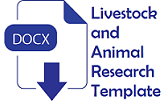Investigasi kapasitas kepemimpinan dalam kelompok peternak sapi PO Kebumen di pesisir Kabupaten Kebumen
Abstract
Objective: The sustainability of the Kebumen Ongole Grade cattle farmers groups in the coastal area of Kebumen Regency has become very important to support the increase in beef cattle production in the countryside. Leadership capacity is the ability of group leaders in managing groups and their members toward more dynamic groups of farmers. This study aimed to identify the leadership capacity of Kebumen Ongole Grade cattle farmers and analyze the relationship between demographic factors and the leadership capacity of Kebumen Ongole Grade cattle farmers.
Methods: One hundred forty-seven respondents of Kebumen Ongole Grade cattle farmers were taken using the multistage sampling method to provide an assessment of the leadership capacity of the head of Kebumen Ongole Grade cattle farmers group. The collected data were analyzed with descriptive statistics and Spearman rank correlation
Results: The analysis showed that the age of the group leader, the experience of the group leader involved in the farmers group, and the experience of the group leader in raising beef cattle has a significant relationship with the leadership capacity in the group (P <0.05).
Conclusions: The heads of the Kebumen Ongole Grade cattle farmers groups had high leadership capacity.
Keywords
Full Text:
PDF (Bahasa Indonesia)References
- Sugiarto, M., S. Nur, Djatmiko OE, and Gayatri S. 2019. Discrepancy, and spatial grouping of individual potential among Kebumen Ongole Grade cattle farmers in Kebumen Regency. J. Indonesian Trop. Anim. Agric. 44:195-203. Doi:10.14710/jitaa.44.2.195-203
- Rustinsyah R. 2019. The significance of social relations in rural development: A case study of a beef-cattle farmer group in Indonesia. J. Co-op. Organ. Manag. 7:100088. Doi:10.1016/j.jcom.2019.100088
- Suheimi, D., A. Fatchiya, and S. Harijati. 2019. Faktor-faktor yang mempengaruhi dinamika kelompok di Kabupaten Cirebon. Jurnal Penyuluhan. 15:97-110. Doi:10.25015/penyuluhan.v15i1.21861
- Uhl-Bien, M. and M. Arena. 2018. Leadership for organizational adaptability: A theoretical synthesis and integrative framework. Leadersh. Q. 29:89-104. Doi:10.1016/j.leaqua.2017.12.009
- Surji, M. K. 2013. Understanding leadership and factors that influence leaders’ effectiveness. Eur. J. Bus. Manag. 7:154-167. Doi:10.7176/EJBM/7-33-2015-03
- Dubrin, A. J. 2007. Leadership: research findings, practice and skills. Houghton Mifflin Company, New York
- Umar, H. 2005. Metode penelitian untuk bisnis. Raja Grafindo Persada, Jakarta
- Meuwissen, M. P. M., P. H. Feindt., A. Spiegel, C. J. A. M. Termeer, E. Mathijse, Y. de Mey, R. Finger, A. Balmann, E. Wauters, J. Urquhart, M. Vigani, K. Zawalińska, H. Herrera, P. Nicholas-Davies, H. Hansson, W. Paas, T. Slijper, I. Coopmans, W. Vroege, A. Ciechomska, F. Accatino, B. Kopainsky, M. Poortvliet, J. J. L. Candel, D. Maye, S. Severini, S. Senni, B. Soriano, C. J. Lagerkvist, M. Peneva, C. Gavrilescu, and P. Reidsma. 2019. A framework to assess the resilience of farming systems. Agric. Syst. 176. Doi:10.1016/j.agsy.2019.102656
- Andersson, T., M. Cäker, S. Tengblad, and M. Wickelgren. 2019. Building traits for organizational resilience through balancing organizational structures. Scand. J. Manag. 35:36-45. Doi:10.1016/j.scaman.2019.01.001
- Sachs, J. 2004. The problem of the principalship: attracting people to difficult jobs. In R. H. Ahmad and T. F. Hee (Eds.), Principalship and School Management, Principals’ Institute, Faculty of Education, University of Malaya, Kuala Lumpur.
- Hallinger, P. 2005. Instructional leadership and the school principal: A passing fancy that refuses to fade away. Leader. Pol. Schools. 4:221-240.
- Ofuoku, A. U. and J. U. Agbamu. Leadership effectiveness among farmers' self-help groups in Central Agricultural Zone of Delta State, Nigeria and its implication for improved agricultural extension service. Asian J. Agric. Ext. Econ. Sociol. 2:41-53. Doi:10.9734/AJAEES/2013/2869
- Subasic, E., K. J. Reynolds, J. C. Turner, K. E. Veenstra, and S. A. Haslam. 2010. Leadership, power and the use of surveillance: Implications of shared social identity for leaders’ capacity to influence. Leadersh. Q. 22:170-181. Doi:10.1016/j.leaqua.2010.12.014
- Hughes, D. J., A. Lee, T. A. Wei, A. Newman, and C. Knight. 2018. Leadership, creativity, and innovation: A critical review and practical recommendations. Leadersh. Q. 29:549-569. Doi:10.1016/j.leaqua.2018.03.001
- Huang, L., D. V. Krasikova, and D. Liu. 2016. I can do it, so can you: The role of leader creative self-efficacy in facilitating follower creativity. Organ. Behav. Hum. Decis. Process. 132:49-62. Doi:10.1016/j.obhdp.2015.12.002
- Scheibe, S. and H. Zacher. 2013. A lifespan perspective on emotion regulation, stress, and well-being in the workplace. In P. L. Perrewé, J. Halbesleben, & C. C. Rosen (Eds.), Res. Occup. Stress Wellbeing. 11:167–197. Doi:10.1108/S1479-3555(2013)0000011010
- Forgas, J. and H. Bless. 2006. Affect in social thinking and behavior. (12th ed.). Psychology Press, New York.
- Kovac, H., M. Sirol, and M. Sumanjski. 2017. Leadership handbook. South East European Youth Network, Sarajevo, Bosnia and Herzegovina.
- Martiskainen, M. 2016. The role of community leadership in the development of grassroots innovations. Environ. Innov. Soc. Tr. 22:78-89. Doi:10.1016/j.eist.2016.05.002
- Hartviksen, T. A., B. M. Sjolie, J. Aspfors, and L. Uhrenfeldt. 2018. Healthcare middle managers` experiences developing leadership capacity and capability in a public funded learning network. BMC Health. Serv. Res. 18:433. Doi:10.1186/s12913-018-3259-7
- Bartol, K. M. and X. Zhang. 2007. Networks and leadership development: Building linkages for capacity acquisition and capital accrual. Hum. 17:388-401. Doi:10.1016/j.hrmr.2007.08.004
Refbacks
- There are currently no refbacks.










